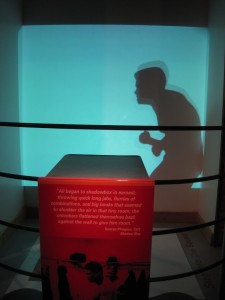Mention Louisville, and the Kentucky Derby comes to mind for most people. And why not? This first leg of the Triple Crown seems to conjure up more imagination and excitement than the other two races combined. When organized horse racing began in antebellum Lexington, black slaves served as trainers and jockeys. A museum located inside Churchill Downsreveals the depth of the African American’s participation along with other racing history. One surprising detail that took me aback was that on opening day of Churchill Downs on May 17, 1875, both the trainer and the jockey of the winner were black. The museum is open to the public.
It’s hard to miss the Louisville SluggerMuseum and Factory. A mammoth 120-foot bat appears to lean against the building, although it’s self-supporting. Among the markings on the the surface of the sculpture that’s designed after Babe Ruth’s bat is the signature of the crafter of the first Louisville Slugger, Bud Hillerich.
Inside, state-of-the-art interactive exhibits allow you to participate in the excitement of the game by challenging baseball greats to pitching and batting. Videos, artifacts and displays focus on the background of some of the African American baseball superstars, such as Jackie Robinson, Hank Aaron, Ernie Banks, the players of the incomparable Negro League and others.
After perusing the museum, take the guided factory tour that follows the creation of Louisville Slugger from the forest to the completed masterpiece. Before you depart, you’ll receive a complementary miniature souvenir bat. When you exit, notice the Walk of Fame that covers 12 city block sidewalks. It features base-shaped bronze plaques of well-known baseball greats.
Cassius Clay grew up and trained in Louisville before he became “The Greatest.” Even though his life led him in a different direction, including a name change, he never forgot his hometown. Guided by his humanitarian spirit, he said, “I have dreamed all my life of creating a place to share, teach, and inspire people to be their best and pursue their dreams.” So he and his wife, Lonnie, founded the Muhammad Ali Center that opened in November 2005.
Of the Center’s seven stories that reveal the boxing champion’s values of respect, confidence, conviction, dedication, spirituality and giving, I concentrated on the fourth and fifth levels. There you’ll find interactive displays, artwork, videos, artifacts and memorabilia. Look for the replacement Olympic Gold medal that Ali received for the 1996 Summer Games in Atlanta. You won’t find the medal that he won in the Olympics’ in 1960 – he tossed that one in the Ohio River when he became disillusioned after returning to the Jim Crow South. You can test your skill when you shadowbox with Ali, whack the speed bag and discover your core character in the Walk with Ali exhibit. Don’t miss the award-winning presentation, The Greatest, projected on the floor of a boxing ring.
The Ali Center has received the “Best Cultural Attraction in the State of Kentucky Award,” the Pathfinders Travel Magazine’s “Best Places to See a Museum that Touches the Heart and Soul Award” and many others.

